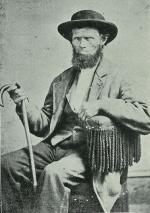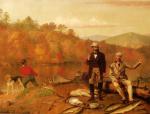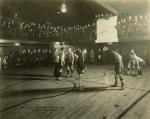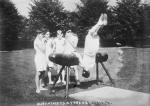Chapter 2: Recreational Sports and Leisure
Today, we don't think twice about a five-mile run or a quick circuit on the weight machines at the local gym to jump-start our hearts before heading off to work in the morning. During lunch, we might stop in for a swim at the Y; after school, we might ride a bike around the neighborhood. If the weather is good, we can hit a few golf balls. If it's hot, we might shoot some pool or go to the bowling alley. We might even go to a ball game, play in one, or just watch one on TV.
The truth is that most of these recreational activities are so much a part of our lives that it is hard to imagine our lives without them. But there is another truth: all of these leisure recreations are relatively new, and many were once frowned upon, if not illegal.
Some of our healthful recreational activities emerged from the necessities of daily life. Pennsylvania's earliest settlers could not have survived without hunting and fishing, for example. They rode horses and rowed boats for transportation, and when they walked, it was typically because they had someplace to go. Their arguments sometimes escalated into a combined fistfight and wrestling match, and as for working out, farm families didn't need gyms or fancy equipment; they tilled, dug, lifted, and chopped–then went to bed physically exhausted, only to repeat the process when the sun rose again.
Carrying over their amusements from Europe, some early Pennsylvanians were so fond of bull and bearbaiting, cockfighting, and wrestling that the Pennsylvania assembly passed laws against these and other immoral amusements associated with both drinking and gambling. In the decade before American independence, Benjamin Franklin wrote, "Idleness and pride tax with heavier hand than kings and Parliaments. If we can get rid of the former, we may easily bear the latter." Though Franklin himself was an avid swimmer, swimming was no idle recreation; it was exercise for his overall well-being, a sound body contributing to a sound mind.
Still, thanks to a trio of connecting forces–the development of market capitalism, industrialization, and the movement towards a more urban society–working hours and leisure hours became compartmentalized in the 1800s, and the physical activities that previously blended the two had separated, as well. What once might have passed for "idleness" to Franklin had evolved into entertainment, relaxation, physical conditioning, and healthy competition.
Men in towns and cities still hunted and fished, but more and more they did so for sport rather than survival. In 1828, for example, Brothers Titian Ramsey and Franklin Peale formed the United Bowmen of Philadelphia, the nation's first society of archers. Fishing for sport with hand-tied flies was already popular on the limestone streams around Easton in the 1840s when
the nation's first society of archers. Fishing for sport with hand-tied flies was already popular on the limestone streams around Easton in the 1840s when  Samuel Phillippe lightened the heft of the rods–to the grateful anglers who have followed–by building them with split bamboo.
Samuel Phillippe lightened the heft of the rods–to the grateful anglers who have followed–by building them with split bamboo.
By mid-century, billiards was replacing bowling as the Commonwealth's most popular sport and was developing its own professional players. In 1858, Englishman Michael Phelan came to Philadelphia and won $1,000 against local favorite Ralph Benjamin in the first recorded billiard match in the United States. Athletic clubs were forming across the Commonwealth to promote all sorts of sporting activities–fishing and hunting, cricket, baseball, rowing, and boxing–while improving road and rail systems were making it easier to reach the resort hotels designed to lure well-heeled urbanites away from dust, noise, and heat of the city with the refreshing promise of open air.
first recorded billiard match in the United States. Athletic clubs were forming across the Commonwealth to promote all sorts of sporting activities–fishing and hunting, cricket, baseball, rowing, and boxing–while improving road and rail systems were making it easier to reach the resort hotels designed to lure well-heeled urbanites away from dust, noise, and heat of the city with the refreshing promise of open air.
In 1816, a promising young state lawmaker named James Buchanan made his first visit to a rural hotel in Bedford Springs. Partial to its restorative mineral waters and bucolic vistas, Buchanan would return when he was president of the United States in the late 1850s, making the now massive Bedford Springs Hotel his summer White House. By the end of the century, the hotel had built one of the first golf courses in the state, and, in 1907, one of the first indoor pools in the country.
Bedford Springs Hotel his summer White House. By the end of the century, the hotel had built one of the first golf courses in the state, and, in 1907, one of the first indoor pools in the country.
Closer to Philadelphia, the Wissahickon Inn featured riding, walking, swimming, boating, and ice-skating when it opened in 1884, and, for its upper-crust clientele, easy access to cricket at the Philadelphia Cricket Club across the road. It would soon add tennis and golf to its menu of recreational activities. Indeed, golf planted one of its earliest American seeds with the creation, some sixty miles northeast of Pittsburgh, of the
Wissahickon Inn featured riding, walking, swimming, boating, and ice-skating when it opened in 1884, and, for its upper-crust clientele, easy access to cricket at the Philadelphia Cricket Club across the road. It would soon add tennis and golf to its menu of recreational activities. Indeed, golf planted one of its earliest American seeds with the creation, some sixty miles northeast of Pittsburgh, of the  Foxburg Golf Course in the 1880s. Over the next two decades the game, with its strict rules and stricter etiquette, became a favored pastime of the moneyed class, particularly among the Philadelphia's upper crust and the steel barons of Pittsburgh. Philadelphia's Main Line became as connected by its new golf and country clubs, which added riding, tennis, shooting, skating, swimming, and other sports, as it had previously been by its railroad stations. There, too, could be found the
Foxburg Golf Course in the 1880s. Over the next two decades the game, with its strict rules and stricter etiquette, became a favored pastime of the moneyed class, particularly among the Philadelphia's upper crust and the steel barons of Pittsburgh. Philadelphia's Main Line became as connected by its new golf and country clubs, which added riding, tennis, shooting, skating, swimming, and other sports, as it had previously been by its railroad stations. There, too, could be found the  Wayne Natatorium, one of the nation's largest pools.
Wayne Natatorium, one of the nation's largest pools.
A new century brought with it new technologies, new sports, and new attitudes toward recreation. Pennsylvanians became so concerned about the disappearance of animal populations because of over-hunting that the state game commission in 1920 purchased more than 6,000 acres in Elk County and there opened the first State Game Lands. Today, the Commission manages nearly 1.5 million reserved acres upon which fish, birds, and game animals large and small can flourish.
State Game Lands. Today, the Commission manages nearly 1.5 million reserved acres upon which fish, birds, and game animals large and small can flourish.
In 1921, radio station KDKA in Pittsburgh became the first radio station to broadcast live baseball, tennis, and football. For the first time in history, it was now possible to experience a live sporting event held elsewhere from the comfort of one's living room. In York,
KDKA in Pittsburgh became the first radio station to broadcast live baseball, tennis, and football. For the first time in history, it was now possible to experience a live sporting event held elsewhere from the comfort of one's living room. In York,  Bob Hoffman turned himself into a multi-faceted evangelist for pumping iron, creating an industry out of manufacturing weights, writing about their benefits, training competitive lifters, and, in the end, helping lay the groundwork for the national fitness craze that would materialize half a century later. The decade also brought skiing to the United States, as a handful of mountains in Pennsylvania's Poconos and the Adirondacks of New York began to offer instruction and equipment.
Bob Hoffman turned himself into a multi-faceted evangelist for pumping iron, creating an industry out of manufacturing weights, writing about their benefits, training competitive lifters, and, in the end, helping lay the groundwork for the national fitness craze that would materialize half a century later. The decade also brought skiing to the United States, as a handful of mountains in Pennsylvania's Poconos and the Adirondacks of New York began to offer instruction and equipment.
Meanwhile, athletic clubs were establishing themselves as full-service community centers. Outside Pittsburgh, the Carnegie Library of Homestead added basketball, bowling, and billiard leagues to its already well-used gymnasium, swimming pool, concert hall, and library. In Philadelphia's Chestnut Hill section, the
Carnegie Library of Homestead added basketball, bowling, and billiard leagues to its already well-used gymnasium, swimming pool, concert hall, and library. In Philadelphia's Chestnut Hill section, the  Wissahickon Boys Club became the first club serving an African-American population to join the National Boys Club Federation. Its pioneering programs combined athletics, job training, and academic tutoring, and they still thrive today, although the club did make one radical overhaul reflected in its current name: the Wissahickon Boys and Girls Club. In the 1940s, Police Athletic Leagues (PAL), in which police officers supervised athletic and educational programs from boxing and basketball to math and reading for kids and teenagers, took root in the larger cities. In Philadelphia, boxer Joe Frazier ascended from PAL rings to become the Olympic and, later, the heavyweight champion of the world.
Wissahickon Boys Club became the first club serving an African-American population to join the National Boys Club Federation. Its pioneering programs combined athletics, job training, and academic tutoring, and they still thrive today, although the club did make one radical overhaul reflected in its current name: the Wissahickon Boys and Girls Club. In the 1940s, Police Athletic Leagues (PAL), in which police officers supervised athletic and educational programs from boxing and basketball to math and reading for kids and teenagers, took root in the larger cities. In Philadelphia, boxer Joe Frazier ascended from PAL rings to become the Olympic and, later, the heavyweight champion of the world.
Once the purview of the youth, recreational activities from running and biking to daily fitness workouts and organized team leagues have been widened to welcome seniors, women, children barely old enough to walk, and, through such programs as the Special Olympics, the physically and mentally challenged.
Today we run marathons in Philadelphia, Scranton, Erie, and Harrisburg; we fish the state's streams and the great rivers; we row in the morning light on the Schuylkill; we bend our bodies in yoga classes; and follow the Pirates, Phillies, Steelers, Eagles, Flyers, and 76ers; the Nittany Lions of Penn State, Pitt's Panthers, and the Fighting Quakers of the University of Pennsylvania; we drive our kids to soccer practice and Little League; play softball on spring mornings, flag football when there's a chill in the air, and hoops in the gym, the schoolyard, and the driveway. How different our lives would be if we didn't.
The truth is that most of these recreational activities are so much a part of our lives that it is hard to imagine our lives without them. But there is another truth: all of these leisure recreations are relatively new, and many were once frowned upon, if not illegal.
Some of our healthful recreational activities emerged from the necessities of daily life. Pennsylvania's earliest settlers could not have survived without hunting and fishing, for example. They rode horses and rowed boats for transportation, and when they walked, it was typically because they had someplace to go. Their arguments sometimes escalated into a combined fistfight and wrestling match, and as for working out, farm families didn't need gyms or fancy equipment; they tilled, dug, lifted, and chopped–then went to bed physically exhausted, only to repeat the process when the sun rose again.
Carrying over their amusements from Europe, some early Pennsylvanians were so fond of bull and bearbaiting, cockfighting, and wrestling that the Pennsylvania assembly passed laws against these and other immoral amusements associated with both drinking and gambling. In the decade before American independence, Benjamin Franklin wrote, "Idleness and pride tax with heavier hand than kings and Parliaments. If we can get rid of the former, we may easily bear the latter." Though Franklin himself was an avid swimmer, swimming was no idle recreation; it was exercise for his overall well-being, a sound body contributing to a sound mind.
Still, thanks to a trio of connecting forces–the development of market capitalism, industrialization, and the movement towards a more urban society–working hours and leisure hours became compartmentalized in the 1800s, and the physical activities that previously blended the two had separated, as well. What once might have passed for "idleness" to Franklin had evolved into entertainment, relaxation, physical conditioning, and healthy competition.
Men in towns and cities still hunted and fished, but more and more they did so for sport rather than survival. In 1828, for example, Brothers Titian Ramsey and Franklin Peale formed the United Bowmen of Philadelphia,
By mid-century, billiards was replacing bowling as the Commonwealth's most popular sport and was developing its own professional players. In 1858, Englishman Michael Phelan came to Philadelphia and won $1,000 against local favorite Ralph Benjamin in the
In 1816, a promising young state lawmaker named James Buchanan made his first visit to a rural hotel in Bedford Springs. Partial to its restorative mineral waters and bucolic vistas, Buchanan would return when he was president of the United States in the late 1850s, making the now massive
Closer to Philadelphia, the
A new century brought with it new technologies, new sports, and new attitudes toward recreation. Pennsylvanians became so concerned about the disappearance of animal populations because of over-hunting that the state game commission in 1920 purchased more than 6,000 acres in Elk County and there opened the first
In 1921, radio station
Meanwhile, athletic clubs were establishing themselves as full-service community centers. Outside Pittsburgh, the
Once the purview of the youth, recreational activities from running and biking to daily fitness workouts and organized team leagues have been widened to welcome seniors, women, children barely old enough to walk, and, through such programs as the Special Olympics, the physically and mentally challenged.
Today we run marathons in Philadelphia, Scranton, Erie, and Harrisburg; we fish the state's streams and the great rivers; we row in the morning light on the Schuylkill; we bend our bodies in yoga classes; and follow the Pirates, Phillies, Steelers, Eagles, Flyers, and 76ers; the Nittany Lions of Penn State, Pitt's Panthers, and the Fighting Quakers of the University of Pennsylvania; we drive our kids to soccer practice and Little League; play softball on spring mornings, flag football when there's a chill in the air, and hoops in the gym, the schoolyard, and the driveway. How different our lives would be if we didn't.












